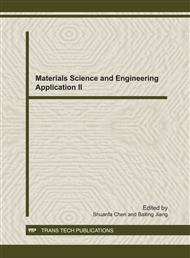[1]
CHAI Liyuan, TANG Nin, MING Xiaobao, ZHUANG Minglong, in: Treatment of Chromium Wastewater by Immobilized Sulfate-reducing Bacteria-containing Activated Sludge, Journal of Central South University(Science and Technology), vol. 6, pp.965-970, (2005).
Google Scholar
[2]
YIN Hua, LU Xianyan, PENG Hui, YE Jinshao, in: Improvement of Heavy Metal Removing Strain by Protoplast Combination Mutant , Environmental Science, vol. 4, pp.147-151, (2005).
Google Scholar
[3]
YE Jinshao, YIN Hua, in: Treatment of Chromium Containing Wastewater by Effective Biosorbents, China Environment Science, vol. 25(2) , pp.245-248, (2005).
Google Scholar
[4]
BroomGP,et a1.in: the Treatment of Heavy Metal Effluents by Crossflow Microfiltration, Journal of Membrane Science, vol. 87, pp.219-230, (1994).
DOI: 10.1016/0376-7388(93)e0152-a
Google Scholar
[5]
TIE Liyun, HONG Hailie, ZHOU Yong, in: Experimental Studies on Adsorption of Chromium(Ⅵ) by Modified Rectorite, Journal of Wuhan University of Technology , vol. 1, pp.22-26, (2006).
Google Scholar
[6]
YU Xiaojiao, YAO Binghua, ZHOU Xiaode, in: Treatment of Cr(Ⅲ) Wastewater with Emulsion Liquid Membrane, Journal of Chemical Industry and Engineering(China), vol. 10, pp.1736-1739, (2004).
Google Scholar
[7]
HE Sijun and ZHAO Xuan: Removal of Chromate(Ⅵ) from Drinking Water by Weak Base Anion Exchange Resins, J T Singhua Univ(Science and Technology), vol. 42(5) , pp.662-668 (2002).
Google Scholar
[8]
WU Keming, SHI Ying, WANG Jun, etal. in: Researches on the Removal of Chromium Pollution from Dulling Wastewater with Ion-Exchange Resins, Industrial Safety and Environmental Protection, vol. 31(4) , pp.22-23, (2005).
Google Scholar
[9]
ZHANG Zijian: Applied Study of Microelectrolysis Process Used for Treatment of Wastewater, Industrial Safety and Environmental Protection, vol. (4) , pp.8-10, (2004).
Google Scholar
[10]
HU Tao, and LI Yayun: Chromium-containing Wastewater Treatment Research. Pollution Control Technology , vol. 8(18), pp.5-7, (2005).
Google Scholar
[11]
Gierak: An Overview of Semiconductor Photocatalyst, Adsorption Science& Technology, vol. 14(1), pp.47-57, (1996).
Google Scholar
[12]
BAI Shulin, ZHAO Guiying, FU Xixian, in: Improvement of Adsorption Cr(Ⅲ) of from Equeous Solution by Active Carbon, Chemical Research and Application, vol. 16(6), pp.670-674, (2001).
Google Scholar
[13]
Fugene papirer.Carbon,vol. 25(2), pp.243-247, (1987).
Google Scholar
[14]
The National Environmental Protection Agency"Monitoring and analytic method to water and wastewater"Editorial Committee, Monitoring and analytic method to water and wastewater, Beijing,China Environmental Science Publishing House, pp.346-349, (2002).
Google Scholar
[15]
Boehm. High Temperatures-High Pressures, vol. 22, pp.275-288, (1990).
Google Scholar


